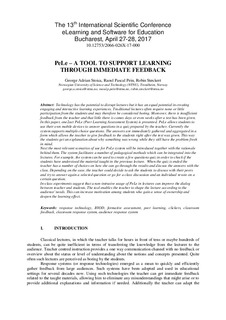| dc.contributor.author | Stoica, George Adrian | |
| dc.contributor.author | Pein, Raoul Pascal | |
| dc.contributor.author | Støckert, Robin | |
| dc.date.accessioned | 2018-04-05T07:56:39Z | |
| dc.date.available | 2018-04-05T07:56:39Z | |
| dc.date.created | 2017-08-18T12:04:48Z | |
| dc.date.issued | 2017 | |
| dc.identifier.citation | eLearning and Software for Education. 2017, 2 197-204. | nb_NO |
| dc.identifier.issn | 2066-026X | |
| dc.identifier.uri | http://hdl.handle.net/11250/2492730 | |
| dc.description.abstract | Technology has the potential to disrupt lectures but it has an equal potential in creating engaging and interactive learning experiences. Traditional lectures often require none or little participation from the students and may therefore be considered boring. Moreover, there is insufficient feedback from the teacher and that little there is comes days or even weeks after a test has been given. In this paper, one2act PeLe (Peer Learning Assessment System) is presented. PeLe allows students to use their own mobile devices to answer questions in a quiz prepared by the teacher. Currently the system supports multiple choice questions. The answers are immediately gathered and aggregated in a form which allows the teacher to give feedback to the students right after the test was given. This way the students get an explanation about why something was wrong while they still have the problem fresh in mind. Next the most relevant scenarios of use for PeLe system will be introduced together with the rationale behind them. The system facilitates a number of pedagogical methods which can be integrated into the lectures. For example, the system can be used to create a few questions quiz in order to check if the students have understood the material taught in the previous lecture. When the quiz is ended the teacher has a number of choices on how she can go through the results and discuss the answers with the class. Depending on the case, the teacher could decide to ask the students to discuss with their peers and try to answer again a selected question or go for a class discussion and an individual revote on a certain question. In-class experiments suggest that a non-intrusive usage of PeLe in lectures can improve the dialog between teacher and students. The tool enables the teacher to shape the lecture according to the audience' needs. This can increase motivation among students who gain a sense of ownership and deepen the learning effect. | nb_NO |
| dc.language.iso | eng | nb_NO |
| dc.publisher | Carol I National Defence University | nb_NO |
| dc.title | PeLe – A Tool To Support Learning Through Immediate Feedback | nb_NO |
| dc.type | Journal article | nb_NO |
| dc.description.version | publishedVersion | nb_NO |
| dc.source.pagenumber | 197-204 | nb_NO |
| dc.source.volume | 2 | nb_NO |
| dc.source.journal | eLearning and Software for Education | nb_NO |
| dc.identifier.doi | 10.12753/2066-026X-17-113 | |
| dc.identifier.cristin | 1487210 | |
| dc.description.localcode | This article will not be available due to copyright restrictions (c) 2017 by Carol I National Defence University | nb_NO |
| cristin.unitcode | 194,63,60,0 | |
| cristin.unitname | Institutt for allmennfag | |
| cristin.ispublished | true | |
| cristin.fulltext | preprint | |
| cristin.qualitycode | 1 | |
